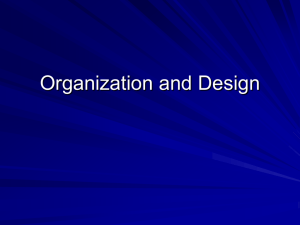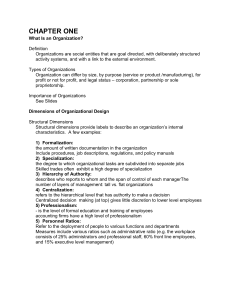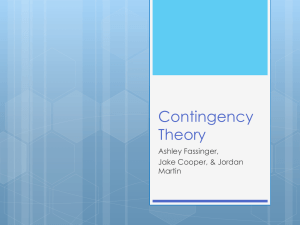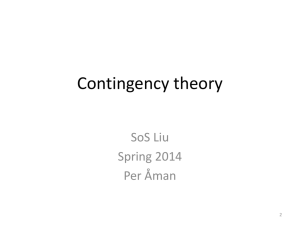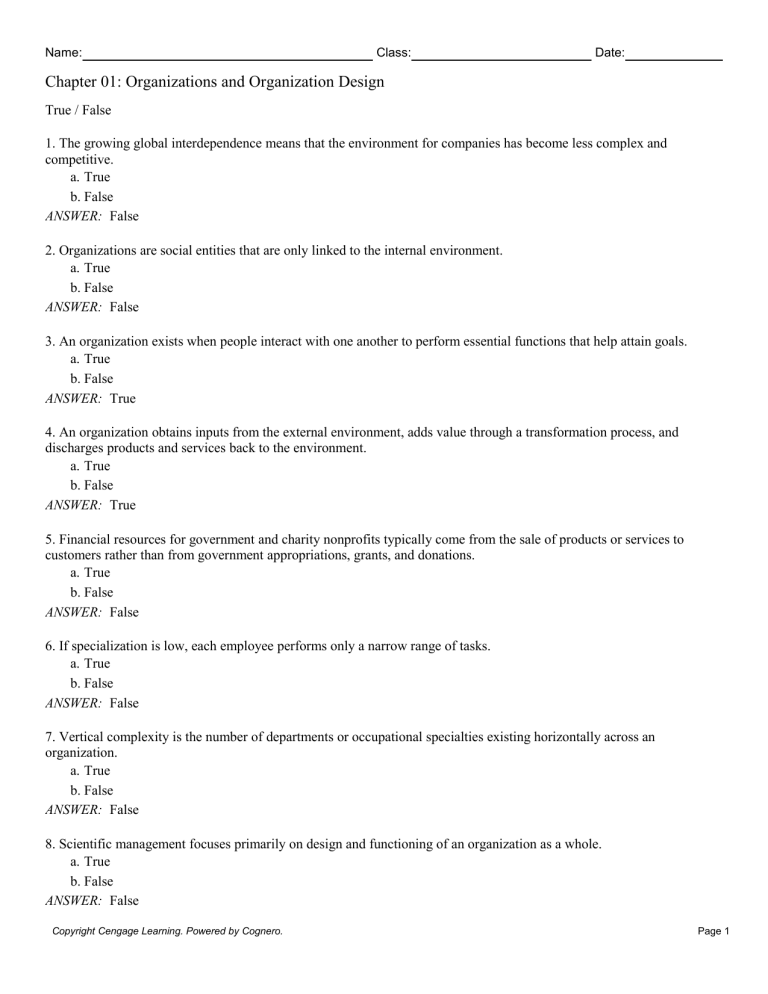
Name: Class: Date: Chapter 01: Organizations and Organization Design True / False 1. The growing global interdependence means that the environment for companies has become less complex and competitive. a. True b. False ANSWER: False 2. Organizations are social entities that are only linked to the internal environment. a. True b. False ANSWER: False 3. An organization exists when people interact with one another to perform essential functions that help attain goals. a. True b. False ANSWER: True 4. An organization obtains inputs from the external environment, adds value through a transformation process, and discharges products and services back to the environment. a. True b. False ANSWER: True 5. Financial resources for government and charity nonprofits typically come from the sale of products or services to customers rather than from government appropriations, grants, and donations. a. True b. False ANSWER: False 6. If specialization is low, each employee performs only a narrow range of tasks. a. True b. False ANSWER: False 7. Vertical complexity is the number of departments or occupational specialties existing horizontally across an organization. a. True b. False ANSWER: False 8. Scientific management focuses primarily on design and functioning of an organization as a whole. a. True b. False ANSWER: False Copyright Cengage Learning. Powered by Cognero. Page 1 Name: Class: Date: Chapter 01: Organizations and Organization Design 9. With decentralization, decision-making authority is pushed up to higher organizational levels. a. True b. False ANSWER: False 10. Organizational behavior is concerned with people aggregated into departments and organizations and with the differences in structure and behavior at the organization level of analysis. a. True b. False ANSWER: False Multiple Choice 11. Organization design: a. encompasses larger elements that influence structural dimensions, including the organization’s size, technology, environment, culture, and goals. b. gives us the tools to evaluate and understand how and why some organizations grow and succeed while others do not. c. obtains inputs from the external environment, adds value through a transformation process, and discharges products and services back to the environment. d. provides labels to describe the internal characteristics of an organization. ANSWER: b 12. _____ refers to economic development that generates wealth and meets the needs of the current generation while saving the environment so future generations can meet their needs as well. a. Centralization b. Formalization c. Contingency d. Sustainability ANSWER: d 13. Pendant Inc., a retail chain based in England, has implemented an energy-efficient trucking fleet. It is increasing its use of green materials in buildings, and aims to dispose all the waste of the company by 2025. Which of the following measures is Pendant Inc. focusing its efforts on? a. Going green b. Scientific management c. Contingency d. Centralization ANSWER: a 14. _____ refers to technologies, skills, and processes for searching and examining massive sets of data to uncover hidden patterns and correlations. a. Scientific management b. Social business c. A social media program Copyright Cengage Learning. Powered by Cognero. Page 2 Name: Class: Date: Chapter 01: Organizations and Organization Design d. Big data analytics ANSWER: d 15. Which of the following is a difference between for-profit businesses and nonprofit organizations? a. Financial resources for for-profit businesses come from government appropriations, grants, and donations, while nonprofit organizations are funded by the sale of products or services to customers. b. In for-profit businesses, managers focus on improving an organization’s products and services to increase sales revenues, while in nonprofit organizations, however, services are typically provided to nonpaying clients. c. For-profit businesses are committed to servicing clients with limited funds, while nonprofit organizations have access to unlimited funds to service clients. d. In for-profit businesses, services are typically provided to nonpaying clients, while in nonprofit organizations, services are typically provided to paying clients. ANSWER: b 16. _____ provide labels to describe the internal characteristics of an organization. a. Functional dimensions b. Administrative principles c. Contingency factors d. Structural dimensions ANSWER: d 17. _____ encompass larger elements that influence structural dimensions, including an organization’s size, technology, environment, culture, and goals. a. Functional dimensions b. Administrative principles c. Contingency factors d. Structural dimensions ANSWER: c 18. Which of the following is true of contingency factors? a. They describe the organizational setting that influences and shapes the structural dimensions. b. They create a basis for measuring and comparing organizations. c. They provide labels to describe the internal characteristics of an organization. d. They describe who reports to whom and the span of control for each manager. ANSWER: a 19. _____ pertains to the amount of written documentation in an organization. a. Centralization b. Specialization c. Decentralization d. Formalization ANSWER: d 20. _____ is the degree to which organizational tasks are subdivided into separate jobs. a. Centralization Copyright Cengage Learning. Powered by Cognero. Page 3 Name: Class: Date: Chapter 01: Organizations and Organization Design b. Specialization c. Decentralization d. Formalization ANSWER: b 21. _____ describes who reports to whom and the span of control for each manager. a. Organizational technology b. Scientific management c. Hierarchy of authority d. Administrative principles ANSWER: c 22. _____ refers to the number of distinct departments or activities within an organization. a. Complexity b. Specialization c. Decentralization d. Formalization ANSWER: a 23. _____ complexity is the number of levels in the hierarchy of an organization. a. Spatial b. Vertical c. Lateral d. Horizontal ANSWER: b 24. _____ complexity is the degree to which an organization’s departments and personnel are dispersed geographically. a. Spatial b. Vertical c. Lateral d. Horizontal ANSWER: a 25. _____ refers to the tools, techniques, and actions used to transform inputs into outputs. a. Organization design b. Organizational performance c. Organizational technology d. Organizational behavior ANSWER: c 26. _____ refers to the amount of resources used to achieve an organization’s goals. a. Effectiveness b. Contingency c. Sustainability Copyright Cengage Learning. Powered by Cognero. Page 4 Name: Class: Date: Chapter 01: Organizations and Organization Design d. Efficiency ANSWER: d 27. _____ is the degree to which an organization achieves its goals. a. Effectiveness b. Contingency c. Sustainability d. Efficiency ANSWER: a 28. _____ primarily focus on the design and functioning of an organization as a whole. a. Structural dimensions b. Administrative principles c. Contingency factors d. Functional dimensions ANSWER: b 29. _____ emphasize designing and managing organizations on an impersonal, rational basis through such elements as clearly defined authority and responsibility, formal recordkeeping, and uniform application of standard rules. a. Structural dimensions b. Administrative principles c. Contingency factors d. Bureaucratic organizations ANSWER: d 30. A(n) _____ design means that an organization is much looser, free-flowing, and adaptive. a. organic b. specialized c. vertical d. mechanistic ANSWER: a 31. Subzero Enterprises is a publishing company based in the United States of America. The company has 70 employees. Information flows in all directions within and across departments and hierarchical levels. The rules and regulations at Subzero Enterprises are flexibly applied. Subzero Enterprises follows a(n) _____ design. a. vertical b. specialized c. organic d. mechanistic ANSWER: c 32. Which of the following contingency factors will influence whether an organization is more effective with a primarily mechanistic organization design? a. Service technology Copyright Cengage Learning. Powered by Cognero. Page 5 Name: Class: Date: Chapter 01: Organizations and Organization Design b. Large size c. Adaptive culture d. Innovation strategy ANSWER: b 33. Which of the following contingency factors will influence whether an organization is more effective with a primarily organic design? a. Manufacturing technology b. Stable environment c. Adaptive culture d. Efficiency strategy ANSWER: c 34. At Infosoft Solutions, employees are encouraged to take care of their problems by working with one another and with customers, using their discretion to make decisions. From this information, it can be understood that Infosoft Solutions is a _____ organization. a. decentralized b. centralized c. mechanistic d. bureaucratic ANSWER: a 35. A _____ is a narrowly defined piece of work assigned to a person. a. task b. role c. job d. designation ANSWER: a 36. A _____ has discretion and responsibility, allowing a person to use his or her judgment and ability to achieve an outcome or meet a goal. a. task b. role c. structure d. system ANSWER: b 37. Which of the following types of communication is emphasized by mechanistic organizations? a. Lateral communication b. Spatial communication c. Horizontal communication d. Vertical communication ANSWER: d Copyright Cengage Learning. Powered by Cognero. Page 6 Name: Class: Date: Chapter 01: Organizations and Organization Design 38. Which of the following types of communication is emphasized by organic organizations? a. Lateral communication b. Spatial communication c. Horizontal communication d. Vertical communication ANSWER: c 39. _____ is the micro approach to organizations because it focuses on the individuals within organizations as the relevant units of analysis. a. Organizational behavior b. Organization design c. Organization theory d. Organizational culture ANSWER: a 40. Which of the following is a difference between organization design and organizational behavior? a. Organization design focuses on individuals within organizations, while organizational behavior analyzes the whole organization as a unit. b. Organization design is concerned with cognitive and emotional differences among people within organizations, while organizational behavior is concerned with the differences in structure and behavior at the organization level of analysis. c. Organization design is concerned with lower management, while organizational behavior is concerned with top- and middle-management. d. Organization design might be considered the sociology of organizations, while organizational behavior is the psychology of organizations. ANSWER: d 41. Under Jeff Immelt’s leadership at General Electric, managers were encouraged to find ways to reduce emissions, invest in clean energy, and develop products that had a lower impact on the environment. Which of the following global challenges was GE responding to? a. Speed and responsiveness b. Going green c. Intense competition d. Big data analytics ANSWER: b 42. Kodak, once considered the leading film and camera producer, was one of the first to invest in developing digital cameras, yet the organization’s managers decided against launching the product because they feared it would detract from sales of its existing photographic products. Kodak ultimately declared bankruptcy and no longer produces photographic equipment. Which of the following global challenges did Kodak fail to address? a. Speed and responsiveness b. Going green c. Big data analytics d. Globalization ANSWER: a Copyright Cengage Learning. Powered by Cognero. Page 7 Name: Class: Date: Chapter 01: Organizations and Organization Design 43. You’ve just been named the CEO of a struggling snack manufacturer. Sales of some of the company’s bestselling products have dropped off considerably in recent years, and you know you need to make some changes to the organization’s product lines soon or the firm will go under. Which of the following most likely provides the best opportunities for making immediate changes that will increase demand for your firm’s products? a. Engaging in “green” manufacturing b. Entering new markets around the globe c. Using data analytics to determine current consumer preferences d. Acquiring a competing organization ANSWER: c 44. You are the production manager for a men’s clothing manufacturer. Several years ago, under intense pressure to cut costs, you made the decision to outsource production of your organization’s t-shirts to a low-cost facility in Cambodia. The move significantly reduced expenses and increased profits, enabling your firm to better compete against similar apparel manufacturers. Recently, however, the media has brought attention to the poor working conditions in some Cambodian factories, and there has been a public outcry against companies that take advantage of workers by manufacturing goods under unfair working conditions. You’re now concerned that consumers will stop buying your firm’s Cambodian-made products. Which of the following best describes the challenge you’re facing? a. Intense competition b. Globalization c. Sustainability and ethics issues d. Big data analytics ANSWER: c 45. ABC Construction is a regional organization divided into separate groups working under one name. One group focuses on installing heating and air conditioning systems in new homes, another group installs roofing, and yet another group is dedicated to installing plumbing systems. To which of the following elements of an organization is this information related? a. Being a social entity b. Goals c. A deliberately structured and coordinated system d. Links to the external environment ANSWER: c 46. Poppy, a small boutique, specializes in clothing for the mature woman who wants to look fashionable without looking too young or trendy. The organization’s ideal customer comes from a higher income bracket, is 40+ years old, and seeks unique fashions. To which of the following elements of an organization is this information related? a. Being a social entity b. Goals c. A deliberately structured and coordinated system d. Links to the external environment ANSWER: d 47. In Bangladesh, Nobel Peace Prize-winning economist Muhammad Yunus designed an organization that would manufacture a low-cost, fortified yogurt for toddlers to help lower the high mortality rate among two- and threeyear-old children in that country. The organization would also provide jobs to those who worked in the plant, as well as to women who would sell the product door-to-door, keeping a small percentage of each sale as their commission. Which of the following best describes this organization? Copyright Cengage Learning. Powered by Cognero. Page 8 Name: Class: Date: Chapter 01: Organizations and Organization Design a. For-profit organization b. Nonprofit organization c. Social organization d. Hybrid organization ANSWER: d 48. As the Operations Manager of a manufacturing plant, you have recently become aware of a conflict. The purchasing department wants to switch to a foreign supplier of a particular component part in order to save money, but the manufacturing floor manager says the new supplier’s parts are lower in quality, break more easily, and thus, fewer pieces pass the final inspection, lowering overall production. Which of the following challenges are you facing? a. Solving an ethical dilemma b. Motivating employees to work together to achieve organizational goals c. Creating a more diverse workforce d. Adapting to conducting business in a global environment ANSWER: b 49. At a certain automotive manufacturing plant, each line worker is required to perform three specific actions or steps on an automobile before it moves on to the next person on the line. At a different computer manufacturer, each line worker performs fifteen to eighteen actions on each laptop and tests his or her work before sending the units on to the next station. These two manufacturers are very different in terms of: a. formalization. b. specialization. c. complexity. d. centralization. ANSWER: b 50. Maxi’s Magical Mystery Tour is a nonprofit organization operated by a group of six actors, singers, and dancers. They intend to bring the arts to school-aged children by performing at a minimum of nine grade schools in the tri-state region each school year. To which of the following elements is this information related? a. Being a social entity b. Goals c. A deliberately structured and coordinated system d. Links to the external environment ANSWER: b 51. As the newly hired production manager at a small but growing solar panel manufacturing firm, you were shocked to discover that there is virtually no written documentation detailing the production of various types of panels. The owner explained it by saying that he “trusts his people to know what they’re doing.” You see potential problems with this approach, so which of the following structural dimensions do you think you should focus on addressing first? a. Formalization b. Specialization c. Centralization d. Documentation ANSWER: a Copyright Cengage Learning. Powered by Cognero. Page 9 Name: Class: Date: Chapter 01: Organizations and Organization Design 52. During the first week of his new job as a sales representative for a national auto parts distributor, Tyler attended a regional sales conference. He couldn’t help but notice that of the 400 or so sales reps there, nearly all of them were goodlooking men under 35, like himself. He began to wonder if he got the job because of his skill in sales or because he fit a certain profile. Which aspect of organizational design is Tyler concerned about? a. The hierarchy of authority b. Specialization c. Organizational culture d. Organizational environment ANSWER: c 53. The CEO of a chemical manufacturing plant is reviewing the organization’s effectiveness over the past year. Among other things, she is looking at the plant’s profitability, the volume of chemicals produced, the number of accidents within the plant, the rate of employee turnover, and the degree to which the firm is complying with federal regulations regarding the plant’s impact on the environment. This CEO is taking a(n) _______ approach to measuring effectiveness. a. Stakeholder b. Goal-oriented c. Comprehensive d. Efficient ANSWER: a 54. In some organizations, in which everyone has access to the information they need and the training to make good decisions, it no longer makes sense to have layers of managers. This is particularly true of ________ organizations. a. knowledge-based b. global c. highly centralized d. diversified ANSWER: a 55. Phoenix Software employs fewer than 20 employees. They do not have job titles, and they typically organize themselves into collaborative work teams as new projects arise. Which of the following best describes Phoenix Software? a. Mechanistic b. Centralized c. Informal d. Bossless ANSWER: d Essay 56. In today’s rapidly changing global business environment, managers face many challenges. Briefly summarize the five major challenges discussed in the text. ANSWER: Due to globalization, managers are expected to help their organizations adapt to a business environment in which markets, technologies, and organizations are increasingly interconnected. This growing global interdependence creates new opportunities for organizations, but it has also led to intense competition in an increasingly complex environment. Stakeholders around the globe are demanding that organizations commit to balancing profit with public interest, thus managers must place a new focus on sustainability, the green movement, and ethics. A fourth significant challenge for managers is to respond quickly and decisively to Copyright Cengage Learning. Powered by Cognero. Page 10 Name: Class: Date: Chapter 01: Organizations and Organization Design environmental changes, organizational crises, and shifting customer expectations. And finally, due to the digital revolution, managers must learn to use big data analytics to uncover hidden patterns and correlations that can enhance their organizations’ performance. 57. Differentiate between for-profit businesses and nonprofit firms. ANSWER: The primary difference between for-profit businesses and nonprofit firms is that managers in businesses direct their activities toward earning money for the company and its owners, whereas managers in nonprofits direct much of their effort toward generating some kind of social impact. Financial resources for government and charity nonprofits typically come from government appropriations, grants, and donations rather than from the sale of products or services to customers. In businesses, managers focus on improving the organization’s products and services to increase sales revenues. In nonprofits, however, services are typically provided to nonpaying clients, and a major problem for many organizations is securing a steady stream of funds to continue operating. Nonprofit managers, committed to serving clients with limited funds, must focus on keeping organizational costs as low as possible and demonstrating a highly efficient use of resources. Moreover, for-profit firms often compete with nonprofits for limited donations through their own philanthropic fundraising efforts. 58. Briefly discuss the contingency factors of an organization. ANSWER: Contingency factors include size, organizational technology, the external environment, goals and strategy, and organizational culture. a. Size can be measured for the organization as a whole or for specific components, such as a plant or division. b. Organizational technology refers to the tools, techniques, and actions used to transform inputs into outputs. c. The environment includes all elements outside the boundary of the organization. d. The organization’s goals and strategy define the purpose and competitive techniques that set it apart from other organizations. e. An organization’s culture is the underlying set of key values, beliefs, understandings, and norms shared by employees. 59. Discuss in detail the stakeholder approach. ANSWER: Achieving effectiveness is not always a simple matter because different people want different things from an organization. For customers, the primary concern is high-quality products and services provided in a timely manner at a reasonable price, whereas employees are mostly concerned with adequate pay, good working conditions, and job satisfaction. Managers carefully balance the needs and interests of various stakeholders in setting goals and striving for effectiveness. This is referred to as the stakeholder approach, which integrates diverse organizational activities by looking at various organizational stakeholders and what they want from the organization. A stakeholder is any group within or outside of the organization that has a stake in the organization’s performance. The satisfaction level of each group can be assessed as an indication of the organization’s performance and effectiveness. 60. What is scientific management? How is it used? ANSWER: Pioneered by Frederick Winslow Taylor, scientific management emphasizes scientifically determined jobs and management practices as the way to improve efficiency and labor productivity. Taylor proposed that workers “could be retooled like machines, their physical and mental gears recalibrated for better productivity.” He insisted that management itself would have to change and emphasized that decisions based on rules of thumb and tradition should be replaced with precise procedures developed after careful study of individual situations. To use this approach, managers develop precise, standard procedures for doing each job, select workers with appropriate abilities, train workers in the standard procedures, carefully plan work, and provide wage incentives to increase output. 61. What is a mechanistic design? Copyright Cengage Learning. Powered by Cognero. Page 11 Name: Class: Date: Chapter 01: Organizations and Organization Design ANSWER: A mechanistic design means that an organization is characterized by machine-like standard rules, procedures, and a clear hierarchy of authority. Organizations are highly formalized and are also centralized, with most decisions made at the top. 62. Differentiate between specialized tasks and empowered roles. ANSWER: A task is a narrowly defined piece of work assigned to a person. With a mechanistic design, tasks are broken down into specialized, separate parts, as in a machine, with each employee performing activities according to a specific job description. A role, in contrast, is a part in a dynamic social system. A role has discretion and responsibility, allowing a person to use his or her judgment and ability to achieve an outcome or meet a goal. 63. Discuss how communication takes place in mechanistic and organic organizations. ANSWER: Mechanistic organizations emphasize vertical communication up and down the hierarchy. Top managers pass information downward to employees about goals and strategies, job instructions, procedures, and so forth, and in turn ask that employees provide information up the hierarchy concerning problems, performance reports, financial information, suggestions and ideas, and so forth. In an organic organization, there is greater emphasis on horizontal communication, with information flowing in all directions within and across departments and hierarchical levels. The widespread sharing of information enables all employees to have complete information about the company so they can act quickly. In addition, organic organizations maintain open lines of communication with customers, suppliers, and even competitors to enhance learning capability. 64. Describe the levels of analysis of an organization. ANSWER: Each organization is a system that is composed of various subsystems. Organization systems are nested within systems, and one level of analysis has to be chosen as the primary focus. Four levels of analysis normally characterize organizations. The individual human being is the basic building block of organizations. The human being is to the organization what a cell is to a biological system. The next higher system level is the group or department. These are collections of individuals who work together to perform group tasks. The next level of analysis is the organization itself. An organization is a collection of groups or departments that combine into the total organization. Organizations themselves can be grouped together into the next higher level of analysis, which is the interorganizational set and community. The interorganizational set is the group of organizations with which a single organization interacts. Other organizations in the community make up an important part of an organization’s environment. 65. What is organization theory and design? ANSWER: Organization theory and design is a macro examination of organizations because it analyzes a whole organization as a unit. Organization design is concerned with people aggregated into departments and organizations and with the differences in structure and behavior at the organization level of analysis. Organization design might be considered the sociology of organizations, while organizational behavior is the psychology of organizations. Copyright Cengage Learning. Powered by Cognero. Page 12
